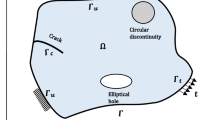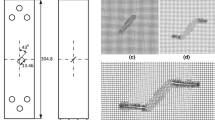Abstract
Finite element analysis (FEA) is the most popular numerical method to simulate plasticity-induced fatigue crack closure and can predict fatigue crack closure behavior. Finite element analysis under plane stress state using 4-node isoparametric elements is performed to investigate the detailed closure behavior of fatigue cracks and the numerical results are compared with experimental results. The mesh of constant size elements on the crack surface can not correctly predict the opening level for fatigue crack as shown in the previous works. The crack opening behavior for the size mesh with a linear change shows almost flat stress level after a crack tip has passed by the monotonic plastic zone. The prediction of crack opening level presents a good agreement with published experimental data regardless of stress ratios, which are using the mesh of the elements that are in proportion to the reversed plastic zone size considering the opening stress intensity factors. Numerical interpolation results of finite element analysis can precisely predict the crack opening level. This method shows a good agreement with the experimental data regardless of the stress ratios and kinds of materials.
Similar content being viewed by others
Abbreviations
- Δa :
-
Element size on crack surface
- Δa ini :
-
Initial crack size
- Δa fin :
-
Final crack size
- H’ :
-
Linear strain hardening rate
- k :
-
Correction factor
- AK :
-
Stress intensity factor range
- AK off :
-
Effective stress intensity factor range
- K op :
-
Crack opening stress intensity factor
- ΔL :
-
Stress range
- R :
-
Stress ratio
- α :
-
Poisson’s ratio
- Δγρ :
-
Reversed plastic zone size
- σ opP :
-
Crack opening stress
- σ y :
-
Yield stress
- ΔSeff :
-
Effective stress ranges
- Smax :
-
Maximum stress
- S ct :
-
Crack closing stress
- AS :
-
Load range
- U :
-
Effective stress intensity factor range ratio
- U assume :
-
Assumed effective stress intensity factor range ratio
- U cal :
-
Calculated effective stress intensity factor range ratio
References
Choi, H. C. and Song, J. H., 1995, “Finite Element Analysis of Closure Behaviour of Fatigue Cracks in Residual Stress Fields,”Fatigue Fract. Engng Mater. Struct., Vol. 18(1), pp. 105–117.
Choi, H. C., 2000, “A Study on the Determination of Closing Level for Finite Element Analysis of Fatigue Crack Closure,”KSME International Journal, Vol. 14, No. 4, pp. 401–407.
Choi, H. C, 2003, “Finite Element Analysis for Fatigue Crack Closure Behavior Using Reversed Plastic Zone Size,”J. of KSME A, Vol. 27, No. 10, pp. 1703–1711, in Korea.
Kim, C. Y., 1993, “Fatigue Crack Closure and Growth Behavior Under Random Loading,” Ph. D. Thesis, Korea Advanced Institute of Science and Technology.
Kurihara, M., Katoh, A. and Kawahara, M., 1987, “Effective of Stress Ratio and Step Loading on Fatigue Crack Propagation Rate,”Current Research on Fatigue (Edited by Tanaka, T, Jono M, Komai K.), Elsevier Applied Science, pp. 247–265.
McClung, R. C. and Sehitoglu, H., 1989, “On the Finite Element Analysis of Fatigue Crack Closure— 1. Basic Modeling Issues,”Engng Fract. Mech., 33, pp. 237–252.
McClung, R. C. and Sehitoglu, H., 1989, “On the Finite Element Analysis of Fatigue Crack Closure ’2. Numerical Results,”Engng Fract. Mech., 33, pp. 253–272.
McClung, R.C., 1991, “Crack Closure and Plastic Zone Sizes in Fatigue,”Fatigue Fract. Engng Mater. Struct., 14(4), pp. 455–468.
Newman, J. C, 1976, “A Finite-Element Analysis of Fatigue Crack Closure,”Mechanics of Crack Growth, ASTM STP 590, pp. 280–301.
Newman, J. C, 1977, “Finite-Element Analysis of Crack Growth Under Monotonie and Cyclic Loading,”Cyclic Stress-Strain and Plastic Deformation Aspects of Fatigue Crack Growth, ASTM STP 637, pp. 56–80.
Ohji, K., Ogura, K. and Ohkubo, Y., 1974, “On the Closure of Fatigue Cracks Under Cyclic Tensile Loading,”Int. J. Fract., 10, pp. 123–134.
Owen, D. J. R. and Fawkes, A. J., 1983, Engineering Fracture Mechanics: Numerical Method and Application, Pineridge Press Limited Swansea, U. K.
Park, S. J., Earmme, Y. Y. and Song, J. H., 1997, “Determination of the Most Appropriate Mesh Size for a 2-d Finite Element Analysis of Fatigue Crack Closure Behaviour,”Fatigue Fract. Engng. Mater. Struct., Vol. 20(4), pp. 533–545.
Rice, J. R., 1967, “Mechanics of Crack Tip Deformation and Extension by Fatigue,”Fatigue Crack Propagation ASTM STP 415, pp. 247–309.
Solanki, K., Daniewicz, S. R. and Newman J. C, 2004, “Finite Element Analysis of Plasticity-Induced Fatigue Crack Closure: An Overview,”Engineering Fracture Mechanics, Vol. 71, pp. 149–171.
Author information
Authors and Affiliations
Corresponding author
Rights and permissions
About this article
Cite this article
Choi, H.C. Numerical analysis for prediction of fatigue crack opening level. KSME International Journal 18, 1989–1995 (2004). https://doi.org/10.1007/BF02990441
Received:
Revised:
Published:
Issue Date:
DOI: https://doi.org/10.1007/BF02990441




